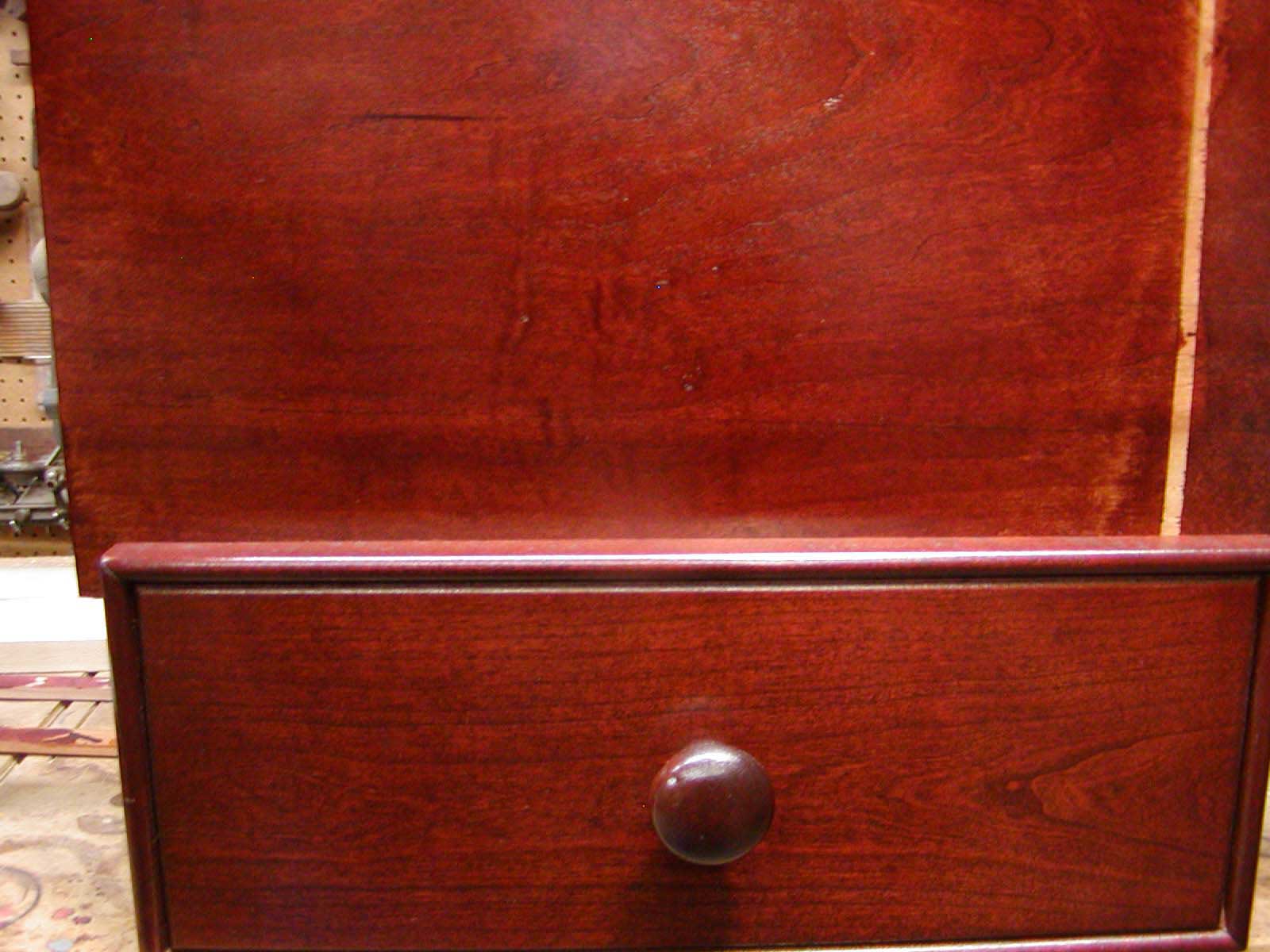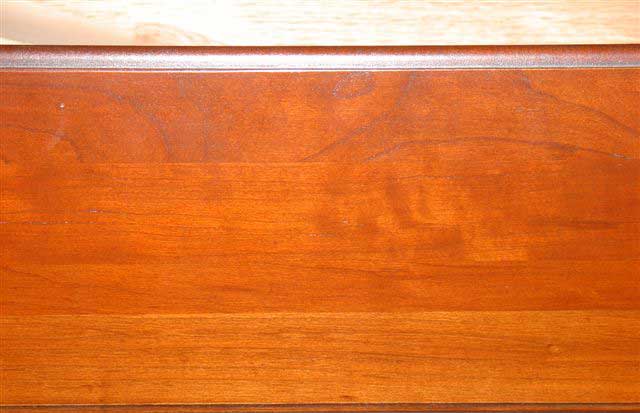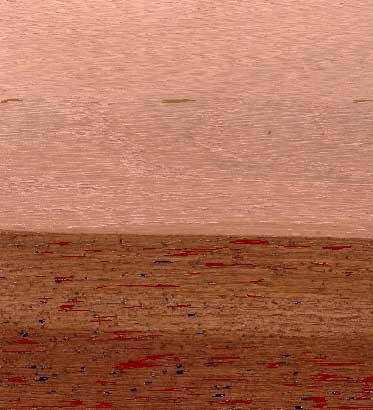Duplicating Finish on Cherry
A beginner gets advice on using a washcoat, wiping stain, and toner to match an existing finish on Cherry. March 1, 2006
Question
I'm just getting started in a custom furniture business. My first commission is to copy a cherry factory produced table. I've got the table made, but I’m having trouble duplicating the stain/finish. I've tried gel stains, washcoats, pigment stains, etc., and the picture below shows my latest sample, which is still unacceptable, compared to the drawer below it. (This sample was a 1lb cut shellac washcoat with a Fuhr waterbase 155 stain/dye sprayed on).
I had some alcohol dyes that didn't look too bad when sprayed on, but I didn't have all the colors needed to get it this dark. So I thought I'd get some advice before ordering more alcohol dyes.
What does everyone recommend? What methods, dyes, procedures, best place to order dyes, etc.? I understand that factories use a multi-stepped process to avoid blotching and wanted to know more about that.

Click here for full size image
Forum Responses
(Finishing Forum)
From contributor G:
I think you may have better luck with better wood and better prep. The drawer isn't any epitome of perfection and you are not far off it. It's just that your wood has different grain and it's not sanded well enough.
From contributor R:
Cherry usually stains best with a washcoat. You should search for Paul Snyder's link to his lesson on washcoats. Even though a washcoat is just a thinned sealer, it is a little more complicated if you want that perfect balance of blocking out the blotching, and still allowing the stain to accentuate the grain. You should experiment with dye stains because they are perfect for this sample. Remember to not try and match the color with the dye, but rather use the dye stain to get closer to the color (think background color).
In this sample you can see a bit of an orange/brown background that can be achieved by misting on some dye stain before your washcoat. After that some stain and then perhaps a toner should get you there. As Contributor G says, you are not far off. I think you should always treat your samples as though they were the finished product. Sand them with the same care as you would give the finished product, after all, this is supposed to be a representation of your finished product.
From contributor R:
Contributor R is right. Dye to get the background color then washcoat/clear stain base to give you blotch control then medium brown wiping stain and finally a toner to get you to your final color. The wiping stain will give you the grain definition that you are missing on your sample and evident in the drawer.
From the original questioner:
I can understand the wiping stain to accent the grain, but if you were doing this, what steps would you take? That is, could you be specific as to exactly what dyes you would use for the background - colors and types (NGR, water, alcohol), and in what order for each? I have tried the water and alcohol before a washcoat, and still got the blotching.
From contributor S:
Below is a simple finish I use on Cherry, Maple, Birch, and other woods that tend to blotch.

Click here for full size image
From the original questioner:
Contributor S - My main concern is duplicating the stain/finish on the drawer in the picture, as that is my current dilemma.
Contributor R - I guess a light went off when I read your post, as I have had some success in my recent attempts with the background color with alcohol dye, a lacquer sealer, and then a wiping stain (the key to pop the grain). I then sprayed a thin layer of dark Jacobean toner over it. I think I'm getting there. I just have to figure out what materials to use to be compatible and not fight each other (stains binders, washcoats, finish etc.)
From contributor S:
I do these finishes every day of my life and they turn out the same every time. My process is actually the same as Ryan mentioned earlier. I do use yellow, orange and red Raw Sienna Dye's as my background colors for a majority of my finishes. I always spray my fyes and they are Acetone or Methanol based. The biggest thing when you are new to dyes is that they dry so fast you don't get to see them wet, so the color will change when you put your clear on them.
1. Dye (orange)
2. Sealer
3. Stain Van Dyke Brown, you could also use glaze to get a nice look.
4. Sealer. You can put dye into sealer to tone with if color isn't right.
5. Top coat
I use Mohawk Finishing Products so colors will vary. The picture you show looks like a color I do a lot and these are the colors I use to get it.
From contributor J:
I see a dark glaze or an oil stain applied at some point in the sample. What I would do is to apply a black or dark brown water based glaze after the 155 and possibly after a light sealing of the 155. This will punch up the grain as in the sample. Your background color is right on, but since you pick up some effect from the glaze color, you may have to adjust.
From contributor M:
Here is another way of making up consistent cherry finishes and an image below.
1. A burnt sienna, with a little white colorant translucent pigmented toner. (pinkish / fresh color)
2. Seal coats
3. Burnt umber glaze - brushed out
4. Brown mahogany dye shading stain
5. Clear coats

Click here for full size image
From contributor R:
Contributor S’s finishing schedule above is a good one for this job. One thing about finishing is that there are many ways to get there, as you can see from all the posts here. For example, to get this color I will sometimes use orange shellac first to seal and at the same time give me the yellow/amber background color, then stain, then tone and top coat. This cuts out one step and gets the same result.
As to the problem of blotching dyes remember that this is a background color and yellow/amber/orange should not be a problem unless you are using too strong of a color.
You said that you sprayed a thin Jacobean toner over and are worried about compatibility? How did you make the toner or is it a thin coat of wiping stain sprayed on? Your comment about compatibility sent up a red flag that you were using a wiping stain as a sprayed toner. If you did use a wiping stain, and the color looks good, then all you need to do is replicate the Jacobean color in a true toner.
From the original questioner:
To contributor R: You are exactly right. The Jacobean was Minwax wiping stain, and I didn't think it would work, but as I stated in my original post, I have to order some more supplies (and the Minwax was all I had that was dark enough)


